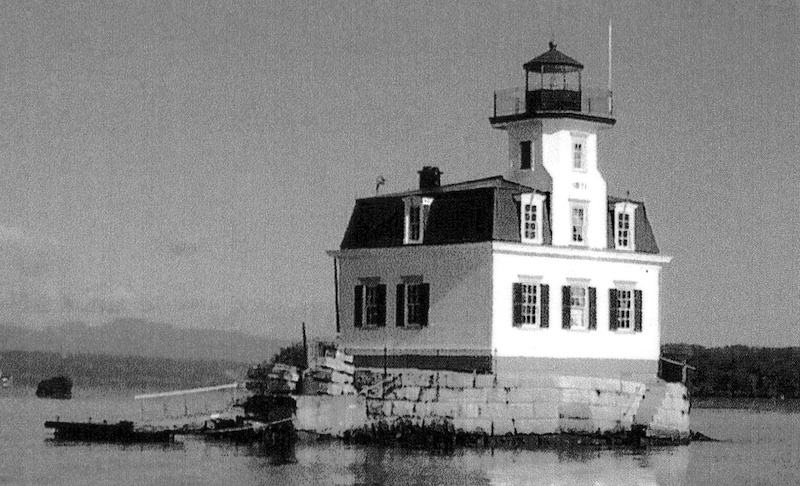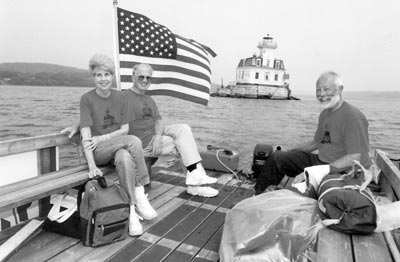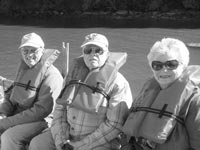
Esopus Meadow Light House Lights Up
Summer 2008
It is a night in 1839. The Esopus Meadows Lighthouse sits on the edge of Esopus Meadows Flats about three miles south of Kingston. It appears to be in the middle of the river. The lighthouse beam casts its warning to the busy cargo and passenger ships making their way through the darkness and into the historical fabric of our day…
According to the late Roy Black Bear, of Esopus, the word “Esopus “means a “small stream or river,” a name generated by the Lenape tribe. The “meadows” in the lighthouse’s name arose from the expanse of grazing land that once existed between the Hudson’s current west shore and the light house. It is now a flooded flat.
The Save Esopus Lighthouse Commission’s literature tells us the land for the lighthouse was purchased for $1 from George Terpening by the US Government on August 28, 1838, (it does not say anything about eminent domain, but one wonders). At the time of the purchase, the land between the lighthouse and the shore was covered by about a foot and a half of water, and then, only periodically.

Volunteers aboard the lighthouse barge on their way to work. They are smiling in spite of the cold rain. L to R: Sam Pierce, Joan Hill, Pat Ralston, George Hill.
Initially, the lighthouse was constructed north of the current structure. It was of bluestone, a locally mined asset. After just over 30 years of harsh winter ice floes it was abandoned.
With two high and two low tides each day, according to author Ruth Glunt. “If ever a lighthouse was needed, it was certainly at the Esopus Meadows.” The current on the channel side of the house runs about two knots. Even more important is the deceptive nature of the Esopus Meadows. The shallow water reaches so far out into the river, many an experienced (or asleep at the wheel) river man has run aground.
The second lighthouse, was built in 1871. Its mansard roof covered a clapboard building that had replaced the original 1839 structure. It has a solid base “built of 250 wood pilings of 40 feet driven down into the riverbed and cut off three feet below the low watermark. The piles were capped off with timbers 12 inches square and planked over with three inch pine. A granite-faced conical pier 49 feet at the base and 46 feet at the top was placed on the planking.”
From 1871 through 1939, the lighthouse was managed by the US Lighthouse Service and a civilian light-keeper and his family lived there. The building had a kitchen, sitting room, office, and a privy on the first floor. The second had three bedrooms and a room used for a fog bell ringing mechanism. (Today the mechanism room is a bathroom).

Leaving EML after a days work. These volunteers enjoy a ride to shore on their barge “The Maid of the Meadows.” L to R: Pat Ralston, John Ralston, Ed Weber.
A flight of stairs leads from the 2nd floor to the watch room and from there a ladder leads to the tower and the light. You can see this in the photo at left. (Not sure which photo this refers to. None of the photos in the material you sent shows this.) The US Coast Guard took over manning the lighthouse in 1939, and in 1965 they closed it as obsolete technology and erected an automated navigational light on a pole outside the building.
Rumors in 1979 that the building was to be demolished spurred a group of area residents to have the structure placed on the National Registry of Historic Places. Arlene Fitzpatrick, niece of a former lighthouse keeper, petitioned the Town of Esopus town board for help, which was granted in the form of a commission of the town to save the lighthouse.

Former keeper & member of the Coast Guard Johnny Olson (middle) going to pay a visit to his beloved Esopus Meadows Lighthouse.
Save Esopus Lighthouse Commission (SELC) leased the lighthouse from the Coast Guard. In August of 2000, US Congress passed the National Lighthouse Preservation Act, and the US Coast Guard deemed the property as “excess” and transferred it to the US Government, making it possible for SELC to become stewards of the lighthouse. In September of 2002, the Esopus Meadows Lighthouse was awarded to the organization Esopus Meadows Lighthouse, newly chartered as a museum. In May of 2003, the US Coast Guard installed a 250 mm lens in the original lantern room and once again, the lighthouse becomes a navigational aid. The outside navigational light installed in 1965 is removed and the Esopus Meadows Lighthouse shines its guiding light again after 38 years of darkness.

Doris McClintock Hubbard shares a laugh with her daughter Barbara on the kitchen steps of EML. Doris lived in the lighthouse from 1927 to 1932 with her keeper father Andrew McClintock and her mother Rebecca.
To see the changes wrought by the members of this ambitious organization, go to their website, EsopusMeadowsLighthouse.org and review the “before and after” photos. Much of the work was performed by volunteers. The work release program of the Ulster County Jail provided welcome manpower for some projects. And grants partially paid for contractors to do some of the larger projects. Keep in mind as you view this renovation, there is no road to this building. Everything, people, tools, equipment, and material, had to reach it by boat.
It is anticipated that restoration will have advanced so that regular tours and possibly a bed & breakfast can begin in 2009.
EsopusMeadowsLighthouse.org website lets you volunteer, donate, or track progress.
Welcome aboard.
